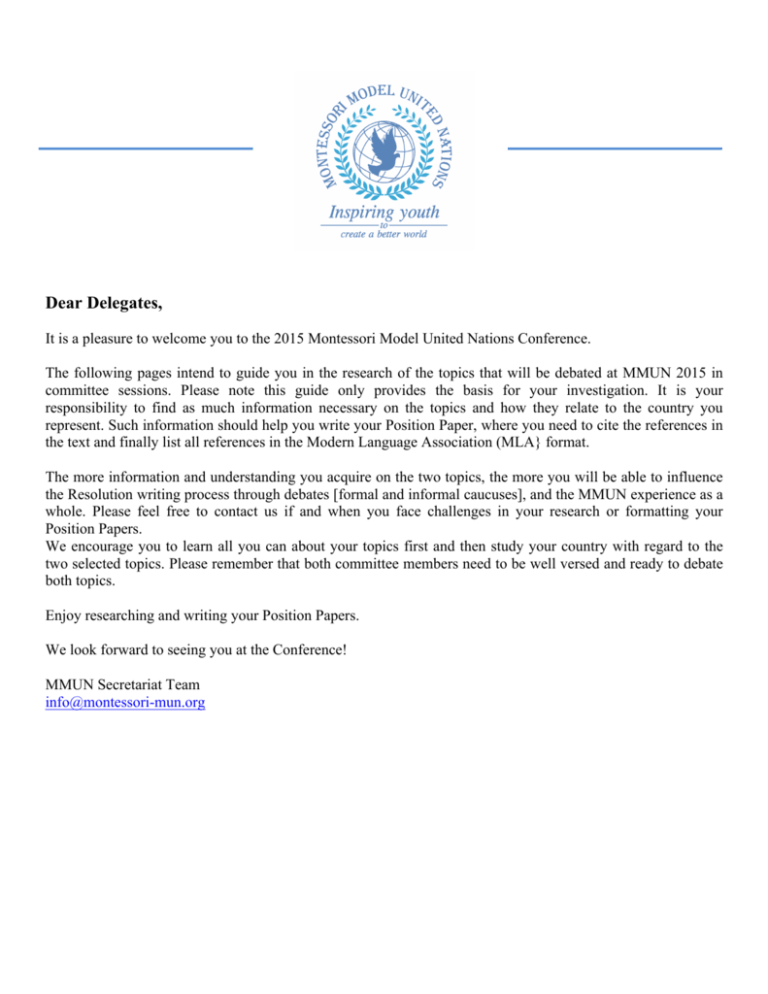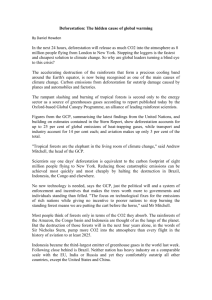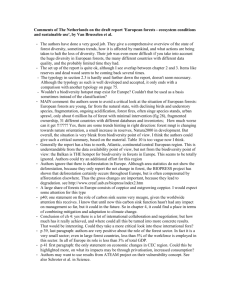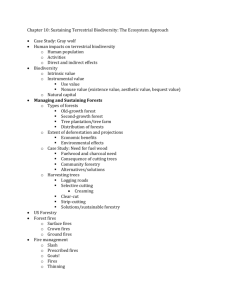
Dear Delegates,
It is a pleasure to welcome you to the 2015 Montessori Model United Nations Conference.
The following pages intend to guide you in the research of the topics that will be debated at MMUN 2015 in
committee sessions. Please note this guide only provides the basis for your investigation. It is your
responsibility to find as much information necessary on the topics and how they relate to the country you
represent. Such information should help you write your Position Paper, where you need to cite the references in
the text and finally list all references in the Modern Language Association (MLA} format.
The more information and understanding you acquire on the two topics, the more you will be able to influence
the Resolution writing process through debates [formal and informal caucuses], and the MMUN experience as a
whole. Please feel free to contact us if and when you face challenges in your research or formatting your
Position Papers.
We encourage you to learn all you can about your topics first and then study your country with regard to the
two selected topics. Please remember that both committee members need to be well versed and ready to debate
both topics.
Enjoy researching and writing your Position Papers.
We look forward to seeing you at the Conference!
MMUN Secretariat Team
info@montessori-mun.org
United Nations Environment Programme
UNEP, established in 1972, is the voice for the environment within the United
Nations system. UNEP acts as a catalyst, advocate, educator and facilitator to
promote the wise use and sustainable development of the global environment. To
accomplish this, UNEP works with a wide range of partners, including United
Nations entities, international organizations, national governments, nongovernmental organizations, the private sector and civil society.
UNEP work encompasses:
•
•
•
•
•
Assessing global, regional and national environmental conditions and trends
Developing international and national environmental instruments
Strengthening institutions for the wise management of the environment
Facilitating the transfer of knowledge and technology for sustainable development
Encouraging new partnerships and mind-sets within civil society and the private sector.
UNEP's global and cross-sectoral outlook is reflected in its organizational structure, its activities and is
personnel. Being based in Africa gives UNEP a clear advantage in understanding the environmental issues
facing the world's developing countries.
Source:http://www.unep.org/Documents.Multilingual/Default.asp?DocumentID=43&ArticleID=3301&l=
en
©Montessori Model United Nations. All rights reserved.
Website: www.montessori-mun.org
Email: info@montessori-mun.org
Deforestation
Topic Background
Deforestation is defined as the cutting, clearing, and removal of the Earth’s forests on a
large scale. According to estimates by the Food and Agriculture Organization in 2010, forests cover about 31%
of the Earth’s total land surface.i More than 60% of these forests are located in seven countries: Russia, Brazil,
Canada, the United States, China, Indonesia, and the Republic of Congo.ii In the 1990s, the world’s forests
disappeared at a rate of 16 million hectares per year (for reference, one hectare is equivalent to 10,000 square
miles).iii From 2000 to 2010, this rate dropped to 13 million hectares per year.iv The global rate of deforestation
has since continued to decrease because of national and international efforts to conserve and protect land
covered by forests. However, as net annual forestry losses continue year after year, it has become increasingly
apparent that the issue of forest sustainability requires the attention of the international community.
The causes of deforestation can be summarized into two main categories: natural causes and human activity.
Natural causes of deforestation include wildfires and overgrazing. Human causes of deforestation include
logging, mining, urbanization, and mass agricultural expansion. In many rural areas, forests help provide a
source of income for people who are able to sell timber for profit, but these trees are often not replanted. Forests
can also be used for their valuable minerals; for example, the Amazon Rainforest contains copper, iron ore, and
gold.v In addition to the resources that can be extracted from forests, the physical land itself has value. When
combined with government corruption and disparities in wealth, urbanization results in the conversion of forest
land. For example, in Brazil, where land ownership is dominated by a wealthy elite class, landless members of
the lower class who struggle to find work in the cities may choose move to forested areas and clear the land.vi
While this alleviates economic instability and prevents political tension from amounting into conflict, the cost
has not come without considerable damage to the Amazon Rainforest. Finally, the clearing of land for
agricultural purposes is the most prevalent reason for deforestation.
Deforestation trends have varied in different regions across the world. Over the past decade, deforestation has
had the largest impact on tropical regions, especially for nations in South America and Africa.vii Europe has
continued losing forestry, though the rate has been slower than that of previous years, while the total forest area
has remained constant in North and Central America.viii Asia has had a net increase in forestry, due in large part
to China, Vietnam, and Indonesia. These nations have developed afforestation programs, in which trees are
planted on land that is not covered by forests (as opposed to reforestation, which is the replanting of trees on
land that had once been covered by forests).
The consequences of deforestation not only affect humans, but also signal shrinking biodiversity for the world
around us. Forests are “carbon sinks” that absorb carbon dioxide from the atmosphere. When trees are cut
down, massive amounts of carbon dioxide are released into the air. It is estimated that forest loss is responsible
for 12 to 17% of annual global greenhouse gas emissions.ix Deforestation also results in soil erosion and the
destruction of animal habitats.
©Montessori Model United Nations. All rights reserved.
Website: www.montessori-mun.org
Email: info@montessori-mun.org
Past International Action
The issue of deforestation as a topic of concern was first introduced on an international
level at the 1972 Conference on Environment and Development (UNCED) in Rio de
Janeiro, Brazil. The product of this conference was a report informally referred to as
the “Forest Principles,” which stated that although nations had the right to profit from
their natural resources, forest lands should not be used without protection, regulation, and conservation.x In
October 2000, the United Nations Economic and Social Council (ECOSOC) created the United Nations Forum
on Forests (UNFF) as an intergovernmental policy forum with the mission to foster “the management,
conservation and sustainable development of all types of forests and to strengthen long-term political
commitment to this end.”xi As a result of heated negotiations from the fifth, sixth, and seventh UNFF meetings,
the UN General Assembly passed the Non-Legally Binding Instrument on All Types of Forests as Resolution
62/98 in December 2007.xii
As outlined by the instrument, the UNFF has four primary points of focus.xiii The first objective is to protect,
conserve, and restore the world’s forests through sustainable forest management (SFM).xiv This is an evolving
concept, as the introduction of new, innovative strategies alters how forests can be maintained optimally for
present and future use. Second, the UNFF assists people who are dependent on forests for a living. Third, the
UNFF works to relocate the production of forest-derived products to sustainably managed forests. Finally, the
UNFF is responsible for ensuring that any conservation efforts are backed with sufficient financial support.
Despite its initial success, the UNFF has garnered criticism in recent years for failing to achieve its mandate.
For instance, critics have called for greater emphasis on addressing the root causes of economic reliance on
trees. Technological advancements have led to the increase of paper consumption worldwide. For China and
India, two emerging global powers, consumption of wood products is also expected to continue increasing.
Trade liberalization initiatives by the World Trade Organization have made it easier to distribute forest-derived
products globally—however, this has come at the expense of forests.xv
Possible Solutions
Due to the nature of how the world’s forests are distributed, the majority of the world’s forests are concentrated
in a small number of nations. However, both timber-producing nations and timber-consuming nations depend
on their survival. Ultimately, it is up to you to research your country’s position and formulate an opinion.
Together, this committee should address three sub-issues: promoting sustainable forest management, providing
social and economic support for forest-dependent people, and mitigating the environmental impacts of
deforestation.
The first two issues come hand-in-hand: how to balance the social and economic needs of indigenous people
without causing permanent damage to the forest ecosystem. Consider researching national efforts for
developing environmentally safe agricultural practices. By implementing rotation harvests, successive harvests
can occur with enough time in between to allow for forest regrowth.xvi In another strategy, forest rehabilitation,
efforts are made to restore a forest to its pre-disturbance condition.xvii Your country’s afforestation or
reforestation programs may also provide specific ideas for how nations can effectively reduce the rate of
deforestation.
©Montessori Model United Nations. All rights reserved.
Website: www.montessori-mun.org
Email: info@montessori-mun.org
In addressing environmental impacts, take a look at recent initiatives by the UN such as
the United Nations Programme on Reducing Emissions from Deforestation and Forest
Degradation (UN-REDD Programme), which was established in 2008. UN-REDD
provides developing nations with incentives for reducing levels of deforestation and
investing in carbon projects.xviii The expansion of UN-REDD or creation of similar
projects could provide steps in the right direction.
Finding the best solutions to deforestation will require the collaborative efforts of both local and global bodies.
During this committee, delegates should focus on encouraging nations to develop policies and practices that will
ensure sustainable management of the world’s forests for many years to come.
Further Research
Guiding Questions
• How can the UN work with existing international organizations to mitigate negative environmental
effects of deforestation?
• How can the UN ensure the success of forest-conservation efforts while balancing financial
dependencies on forest products?
• What punishments should the United Nations be allowed to administer in cases of non-compliance?
Research Sources
• National Geographic overview of deforestation:
http://environment.nationalgeographic.com/environment/global-warming/deforestation-overview/
• The United Nations Forum on Forests: http://www.un.org/esa/forests/
• UN-REDD: http://www.un-redd.org/
©Montessori Model United Nations. All rights reserved.
Website: www.montessori-mun.org
Email: info@montessori-mun.org
“Facts and Figures: Forest Cover.” Food and Agriculture Organization of the United Nations. 9 Nov. 2011.
http://www.fao.org/forestry/28808/en/.
ii “Global Deforestation.” University of Michigan. 4 Jan 2010.
http://www.globalchange.umich.edu/globalchange2/current/lectures/deforest/deforest.html.
iii “World deforestation decreases, but remains alarming in many countries.” Food and Agriculture Organization of the
United Nations. 25 Mar. 2010. http://www.fao.org/news/story/en/item/40893/icode/.
iv Ibid.
v “Extracting valuable minerals and a Pandora’s box of problems.” World Wildlife Foundation. n.d.
http://wwf.panda.org/what_we_do/where_we_work/amazon/problems/other_threats/amazon_mining/.
vi “Global Deforestation.” University of Michigan. 4 Jan 2010.
http://www.globalchange.umich.edu/globalchange2/current/lectures/deforest/deforest.html.
vii “World deforestation decreases, but remains alarming in many countries.” Food and Agriculture Organization of the
United Nations. 25 Mar. 2010. http://www.fao.org/news/story/en/item/40893/icode/.
viii Ibid.
ix Szalay, Jessie. “Deforestation: Facts, Causes, “& Effects.” Livescience. 6 Mar. 2013. http://www.livescience.com/27692deforestation.html.
x General Assembly resolution 151/26, Report of the United Nations Conference on Environment and Development,
A/RES/151/26. 3-14 June 1992. http://www.un.org/documents/ga/conf151/aconf15126-3annex3.htm.
xi “About UNFF.” United Nations Forum for Forests. n.d. http://www.un.org/esa/forests/about.html.
xii Ibid.
xiii “Four Global Objectives on Forests Agreed Upon.” United Nations. n.d.
http://www.un.org/esa/forests/pdf/session_documents/unff6/newsrelease-endofsession.pdf.
xiv “Sustainable Forest Management (SFM)/REDD+.” Global Environment Facility. n.d. http://www.thegef.org/gef/SFM.
xv “Revitalizing the UNFF: Critical Issues and Ways Forward.” 13-16 Feb. 2007.
http://www.cifor.org/publications/pdf_files/events/Paper_UNFF2007.pdf.
xvi “Global Deforestation.” University of Michigan. 4 Jan 2010.
http://www.globalchange.umich.edu/globalchange2/current/lectures/deforest/deforest.html.
xvii Ibid.
xviii “Sustainable Forest Management (SFM)/REDD+.” Global Environment Facility. n.d. http://www.thegef.org/gef/SFM. i
©Montessori Model United Nations. All rights reserved.
Website: www.montessori-mun.org
Email: info@montessori-mun.org









